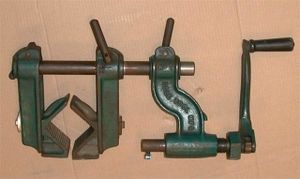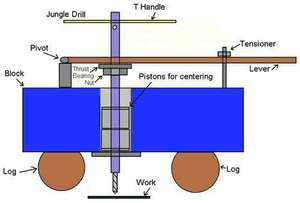Difference between revisions of "Cole drill"
m |
m |
||
| (One intermediate revision by the same user not shown) | |||
| Line 13: | Line 13: | ||
==Instructions on building one (from the [[MultiMachine]] project)== | ==Instructions on building one (from the [[MultiMachine]] project)== | ||
| + | [[Image:jungle_drill.png|thumb|right]] | ||
'''Our “re-discovery” of the “ratchet” drill may be the the most important part of the MultiMachine project.'''<br/> | '''Our “re-discovery” of the “ratchet” drill may be the the most important part of the MultiMachine project.'''<br/> | ||
It began with the request from an engineering professor in Kenya for a drill that would drill large holes in steel and aluminum plates that were being used to build and repair agricultural implements. We found a technique that is now almost forgotten but in the period between the middle 1800's and the early 1900's was how most holes were drilled! You did not drill a hole, you ratcheted one!<br/> | It began with the request from an engineering professor in Kenya for a drill that would drill large holes in steel and aluminum plates that were being used to build and repair agricultural implements. We found a technique that is now almost forgotten but in the period between the middle 1800's and the early 1900's was how most holes were drilled! You did not drill a hole, you ratcheted one!<br/> | ||
| Line 28: | Line 29: | ||
"Cole" type drills may require a very small amount of welding (total bead length is less than 4”) but this can be done using a simple temporary welder that can be made by connecting two or three vehicle batteries in series (negative on one battery to | "Cole" type drills may require a very small amount of welding (total bead length is less than 4”) but this can be done using a simple temporary welder that can be made by connecting two or three vehicle batteries in series (negative on one battery to | ||
positive on the next). The drill spindle assembly can also be made well in advance and the chuck just screwed on to complete construction. <br/> | positive on the next). The drill spindle assembly can also be made well in advance and the chuck just screwed on to complete construction. <br/> | ||
| − | |||
[[Category:Workshop]] | [[Category:Workshop]] | ||
[[Category:Tools]] | [[Category:Tools]] | ||
Latest revision as of 17:11, 19 June 2010
The "Cole Drill" is a ratchet drill made by the Cole Tool Company. The beauty of this type of tool lies in the feed screw. It can be tightened down, exerting extreme pressure on the drill point. Materials such as spring, stainless and tool steel can be drilled with ease using ordinary high speed drill bits.
The Cole Drill great for drilling large holes in pieces that are too large for the drill press. Due to the rigid clamping setup, it will also drill holes with a degree of precision that is not achievable with a hand operated drill motor.
A Cole Drill cuts at low speed with pressure. There are times when you need a hole in a place it would be very hard to get a power tool into, and many say the Cole Drill will cut steel much better than a hand drill. It wouldn't be hard to make one, so I will look into it one day as a project.
The drill is attached to a feedscrew operated by the hand crank. Because of the pressures created, even hardened steels may be cut with ordinary HSS bits.
It's trick is the screw feed which advances the quill to bring 500+ lbs pressure to bear on the drill point. Turn the crank to drill a rev, turn the ring to feed the quill. A 1/2" drill goes through 1/4" steel plate in a dozen revolution
Instructions on building one (from the MultiMachine project)
Our “re-discovery” of the “ratchet” drill may be the the most important part of the MultiMachine project.
It began with the request from an engineering professor in Kenya for a drill that would drill large holes in steel and aluminum plates that were being used to build and repair agricultural implements. We found a technique that is now almost forgotten but in the period between the middle 1800's and the early 1900's was how most holes were drilled! You did not drill a hole, you ratcheted one!
This kind of drill simply breaks down the drilling process into 2 separate parts and changes the usual moderate pressure and high drilling speed to putting great pressure on the drill bit and then turning the bit very slowly by "armstrong" (your strong arm!) power. More work? Sure but can the normal power drill make a 1" hole in a file?
This particular drill was a ratchet drill made by the Cole Tool Company. The power of this type of tool lies in the feed screw that can be tightened down by hand, exerting extreme pressure on the drill point. Materials such as spring, stainless and tool steel can be drilled with by using ordinary high speed steel or masonry carbide type drill bits. The Cole Drill is still useful for drilling large holes in hardened steel or workpieces that are too large for the drill press.
A ratchet drill can be built in many different ways by using the throwout bearing and lever from a manual shift car or truck instead of a harder to build feed screw. The drill bit can be turned with some kind of a handle or a socket wrench ratchet.
One half inch capacity drill chucks are often available for under ten dollars. These are commonly threaded 1/2" x 20tpi so a
threading die this size should be part of your tool kit along with good quality taps and drills for 1/4”, 3/8” and 1/2”. In Metric areas use their metric equivalents.
In the USA, ENCO "USA" made “screw machine” bits are low cost and very good quality.
"Cole" type drills may require a very small amount of welding (total bead length is less than 4”) but this can be done using a simple temporary welder that can be made by connecting two or three vehicle batteries in series (negative on one battery to
positive on the next). The drill spindle assembly can also be made well in advance and the chuck just screwed on to complete construction.

